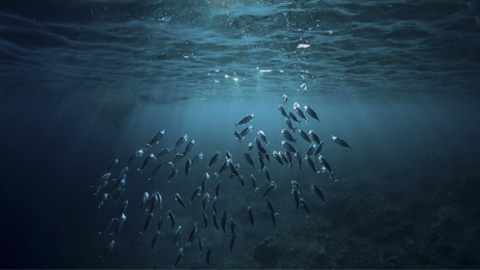How the ancestors of today's marine fishes conquered the oceans
An international team led by researchers from IRTA at the IBB-UAB and the University of Bergen identify a unique set of genes that allows marine teleosts fishes to hydrate their eggs so that they float and disperse for survival in the oceans. The discovered mechanisms shed new light on the evolution of this group of fishes, to which almost all modern marine fishes belong and whose ancestors ventured from freshwater to the saline domain.

Scientists from Spain, Italy and Norway provide new insight into how teleosts, that represent 96% of modern marine fishes, evolved hydration mechanisms that cause their eggs to float in a new study published in Molecular Biology and Evolution. The study uncovers a cluster of water channel genes that only exists in teleost fishes. The genes in question allow water to flow across cell membranes and are specifically expressed in the outer membranes of the maturing egg.
The study was led by Joan Cerdà and Roderick Nigel Finn, researchers of the Institute of Agrifood Research and Technology (IRTA), Spain and the University of Bergen, Norway, at the Institute of Biotechnology and Biomedicine of the Universitat Autònoma de Barcelona (IBB-UAB). Researchers from the Institut de Ciències del Mar (ICM-CSIC), the Spanish Centre for Genomic Regulation (CRG), the Norwegian Institute of Marine Research (IMR) and the University of Padua, Italy also participated.
Although fishes have swum in the sea for hundreds of millions of years, it was not always so. Their ancestors are considered to have evolved in freshwater. This posed a major physiological problem for the first pioneers and their followers that ventured into the saline domain since the salt concentration of their body fluids was, as in humans, much lower than seawater. All modern teleosts reflect this condition and like their ancestors face dehydration due to the passive movement of their body water to the external high salt environment. In contrast to humans who cannot drink seawater due to the inability of our kidneys to eliminate the excess salt, marine teleosts did evolve this ability using specialized cells in their gills. However, there was a major caveat. To fully conquer an environment, it is necessary to reproduce there, but their single-celled eggs lack any of the organ systems of the juveniles and adults and cannot drink seawater. The adaptive solution realized by marine teleosts is that they hydrate their maturing eggs before they are ovulated to provide the developing embryos with the water of life. The amount of hydration determines whether the released eggs are heavier or lighter than the surrounding seawater and thus whether they will sink to the sea floor or float and be dispersed in the oceans.
Duplicate genes with the same function
An unusual aspect of the genes identified by the researchers is that they are closely related duplicates that perform the same function. Typically, when closely related gene duplicates arise, one may acquire a new function or is lost due to overlapping redundancy. «In the present case, the new genes perform the same function in the same membrane of the eggs», explains Joan Cerdà.
By screening hundreds of teleost genomes, the study reveals that virtually all teleost species that produce floating eggs exclusively retain at least one of the genes, with a third of them retaining both genes. By contrast, almost half of the species that produce eggs that sink have lost both genes, and nearly all species that incubate their eggs internally such as sea horses have also lost both genes.
To uncover how floating eggs utilize the genes, the authors employed a broad variety of experimental techniques coupled with state-of-the art DNA sequencing technologies to show that the proteins resulting from each gene evolved specific mechanisms that control their insertion in the outer membranes of the eggs. «When such mechanisms are activated each channel binds to a previously unknown type of protein that keeps the channels in the membrane» says Roderick Nigel Finn. These new proteins discovered by the researchers are also only found in teleost fishes.
A surprising feature is that in modern marine teleosts, a second activation mechanism causes one of the channels to be moved to a different part of the outer egg membrane. In this way, both channels continue to perform the same function and avoid competing for the same space in the membrane. The result is that water flow into the maturing egg is accelerated. The process is terminated when the novel binding proteins are released causing the two channels to leave the outer egg membrane. This locks the acquired water inside the egg.
The hydration mechanism is so efficient that it endows the eggs with more than 90% water. When released into the marine environment and fertilized, the eggs float as passive passengers in the oceanic currents and are thus carried off to new horizons.
Article: Alba Ferré, François Chauvigné, Anna Vlasova, Birgitta Norberg, Luca Bargelloni, Roderic Guigó, Roderick Nigel Finn, Joan Cerdà, Functional evolution of clustered aquaporin genes reveals insights into the oceanic success of teleost eggs, Molecular Biology and Evolution, 2023; msad071, https://doi.org/10.1093/molbev/msad071